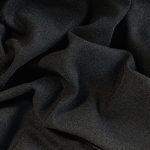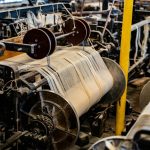Do you know what jute silk fabric is?
It’s a unique textile with a rich history and distinctive properties.
In this article, we’ll explore the origins of jute silk fabric, its characteristics and production process, as well as its various applications.
Additionally, we’ll delve into the sustainable aspects of this fabric, making it an environmentally friendly choice.
So, if you’re curious about jute silk fabric, keep reading to discover all there is to know.
Table of Contents
The History of Jute Silk Fabric
You’ll find it fascinating to learn about the history of jute silk fabric.
Jute silk fabric has its origin in India, where it has been woven for centuries. The evolution of jute silk fabric can be traced back to the ancient times when it was first discovered that jute fibers could be spun into a luxurious and durable fabric.
Over time, the process of weaving jute silk fabric has undergone significant advancements, resulting in the creation of a versatile and highly sought-after textile. The origin of jute silk fabric can be attributed to the natural abundance of jute plants in the Indian subcontinent.
Jute fibers, which are extracted from the stem of the jute plant, are known for their strength and durability. These fibers were first spun into yarn and then woven into fabric using traditional handloom techniques.
The evolution of jute silk fabric has seen the introduction of modern manufacturing processes, such as the use of power looms, which have increased production efficiency and output. Today, jute silk fabric is not only popular in India but also in other parts of the world.
Its unique blend of natural fibers and silk makes it a sustainable and eco-friendly choice for various applications, including clothing, home furnishings, and accessories. The history of jute silk fabric is a testament to the ingenuity and craftsmanship of artisans throughout the ages, and it continues to be a beloved textile in the present day.
Characteristics and Properties of Jute Silk Fabric
Its unique blend of natural fibers gives it a soft and breathable feel. Jute silk fabric is known for its unique characteristics and properties.
The combination of jute and silk creates a fabric that is lightweight and durable. It has a natural sheen and a smooth texture, making it a popular choice for clothing and home furnishings. Jute silk fabric can be dyed using various techniques, allowing for a wide range of vibrant colors and patterns.
When it comes to care instructions, jute silk fabric should be hand washed or dry cleaned to maintain its quality. Avoid using harsh detergents or bleach, as this can damage the fibers. It is best to air dry the fabric or use a low heat setting when using a dryer. Ironing should be done on a low heat setting, and it is advisable to use a pressing cloth to protect the fabric.
How Jute Silk Fabric Is Made
To create jute silk fabric, natural fibers are blended together to form a lightweight and durable material. The manufacturing process starts by harvesting jute plants and extracting long, shiny fibers from their stems. These fibers are then combined with silk fibers, which are obtained from silkworm cocoons. The jute and silk fibers are carefully mixed using a spinning machine to create a fine yarn. This yarn is then woven using traditional weaving techniques to produce jute silk fabric.
The benefits of jute silk fabric are numerous. Firstly, it is an eco-friendly material as both jute and silk are natural fibers that are biodegradable and renewable. This makes jute silk fabric a sustainable choice for environmentally conscious consumers.
Secondly, jute silk fabric is known for its strength and durability. It is resistant to stretching and tearing, making it a long-lasting fabric that can withstand regular wear and tear.
Additionally, jute silk fabric has a unique texture and lustrous appearance. It has a soft and smooth feel, making it comfortable to wear. The fabric also has good moisture absorption properties, making it breathable and ideal for summer clothing.
Jute silk fabric is also versatile and can be used to create a range of products including clothing, accessories, and home furnishings.
Applications and Uses of Jute Silk Fabric
When considering applications and uses, think about the versatility and durability of this unique material. Jute silk fabric has a wide range of advantages that make it suitable for various purposes.
Firstly, its natural fibers give it a soft and smooth texture, making it comfortable to wear. It also has excellent breathability, making it ideal for clothing in hot and humid climates. Additionally, jute silk fabric is highly absorbent, which means it can effectively wick away moisture, keeping you cool and dry.
In terms of applications, jute silk fabric is commonly used in the fashion industry for making dresses, sarees, and other traditional garments. Its elegant appearance and natural sheen make it a popular choice for special occasions. Furthermore, it can also be used for home decor items such as curtains, cushion covers, and table runners, adding a touch of sophistication to any space.
To care for jute silk fabric, it is important to follow a few simple instructions. Firstly, always check the care label for specific washing instructions. In general, it is recommended to hand wash jute silk fabric with mild detergent in cold water. Avoid soaking it for too long and gently squeeze out excess water without wringing. Finally, hang it to dry in a shaded area to prevent fading or damage from direct sunlight.
Sustainable Aspects of Jute Silk Fabric
One of the sustainable aspects of jute silk fabric is that it is made from natural fibers, which reduces the environmental impact compared to synthetic materials. Here are some sustainability benefits and eco-friendly production practices associated with jute silk fabric:
-
Renewable resource: Jute plants grow quickly and require minimal water, pesticides, and fertilizers, making them a sustainable resource for fabric production.
-
Biodegradable: Jute silk fabric is biodegradable, meaning it can decompose naturally without causing harm to the environment.
-
Low energy consumption: The production process of jute silk fabric requires less energy compared to synthetic fabrics, reducing carbon emissions and energy consumption.
-
Carbon sequestration: Jute plants have a high carbon dioxide absorption capacity, helping to reduce greenhouse gas emissions and mitigate climate change.
By choosing jute silk fabric, you are making a sustainable choice that contributes to the preservation of the environment. Its eco-friendly production practices and renewable nature make it an excellent option for those who prioritize sustainability.
Conclusion
In conclusion, jute silk fabric is a unique and sustainable material that has a rich history and various applications.
With its natural sheen and strength, jute silk fabric is known for its durability and versatility.
It is made from the fibers of the jute plant, which is eco-friendly and biodegradable.
Whether used in clothing, home furnishings, or packaging, jute silk fabric offers a sustainable alternative to synthetic materials.
Its popularity continues to grow as more people recognize its benefits and embrace its beauty.
- The Science Behind Activated Carbon Coconut Filter Fabric - June 29, 2025
- Comfort Coconut Fabric Conditioner: A Review for Sensitive Skin - June 29, 2025
- Surf Coconut Bliss Fabric Conditioner: Does It Live up to Its Name? - June 29, 2025






